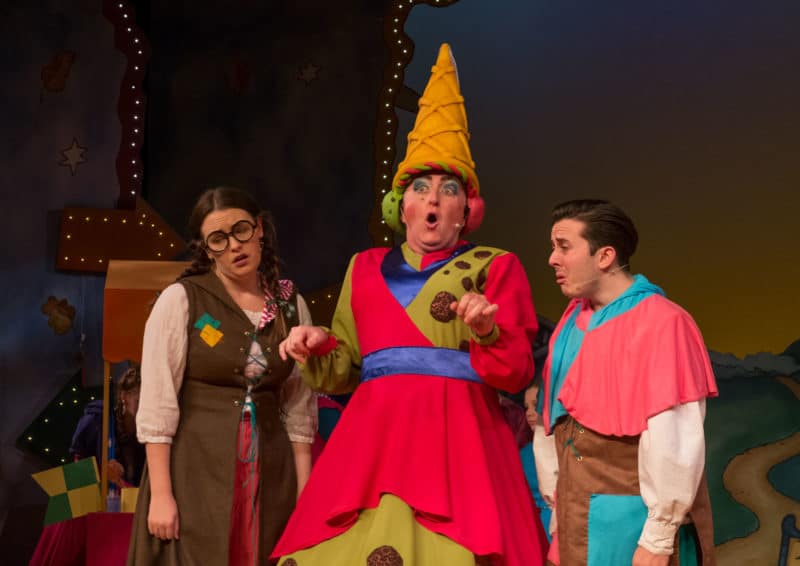Bury Theatre Royal’s Eamonn Fleming proves his dame is all beauty and no beast
Posted on: 14th December, 2016
Actor Eamonn Fleming is a great believer in the old adage that it’s never too late to learn a new skill, and for the past three years he has been learning the not-so-subtle art of being a panto dame.
His baptism of fire, his primary education in Dame School, was at the New Wolsey in Ipswich two years ago, where he played Dame for the first time. Last year his secondary education was received in City Varieties in Leeds and this year he graduates from Dame university at the Theatre Royal in Bury St Edmunds, playing Molly Muffintop in Beauty and the Beast.
Eamonn loves the interaction with an audience. It’s a part that offers the actor a lot of freedom but also comes with an exacting set of rules. It is these rules and the interpretation of those rules which determine not only whether an actor enjoys his time in skirts but whether or not he becomes one of the great Dames of the theatre.
In just three years Eamonn has discovered that no two pantos are the same. The atmosphere and the character of the show change with each theatre and each cast.
The thing that I am learning, more than anything else, is that you have to keep the audience involved in the conversation. That’s the number one task that I have. Regardless of the show, regardless of the story we are telling. The Dame is that direct connection with the audience.
Of course, you can talk to them directly, but it doesn’t have to be as bold as that. When someone else is talking or singing, you can give the audience a nod and wink to point something up or just to let them know that you are on their side.
This link with the audience means the role of the Dame is not the same as stand-up. It requires different skills and a different tone. Stand-up can be quite aggressive, quite confrontational, whereas the Dame needs to invite everyone to be part of the gang. Stand-up is very much a status game but the Dame needs to be much more welcoming.
Although, as with any play, the script is king, the part of the Dame leaves room for the actor to put their particular stamp on the part. I was lucky in that Rob Salmon at The New Wolsey, my first director in panto, encouraged me to just run with it. He said: ‘Find some daft jokes and have fun.’
We’d run stuff – he’d throw some stuff away; like other stuff – and we shaped it together. But it’s not just an act, like it is with stand-up. You are coming in, you introduce yourself, but you are inviting the audience to join in: to take part in the performance.
You are the bridge between the stage and the auditorium. So you have the big scene when you first come on, but, for the rest of the show, it’s striking a balance between being part of the story and maintaining that conversation with the audience. Some panto stars have whole routines that they need to shoehorn in but I am much more interested in being part of the ensemble. The great thing about Bury pantomime is that the laughs can come from anywhere. We have a great cast and everyone is funny.
There’s no stooge or straight-man; we’re all there to tell the story, and it’s important to me that the Dame fits into the show and, as extreme as she is, it feels right that she’s there.
Having a good director helps enormously. Panto isn’t just running about and falling over. Karen (Simpson), the director, knows exactly what she wants. She wants warmth and engagement, and the feel of the show depends very much on the director.
The more I do, the more I can compare. The Ipswich show, the rock’n’roll pantomime, was very slick. It was as much a musical as it was a panto; it had to be, because you had to deliver these amazing songs and produce a panto as well.
Bury is much more community-focussed, which I love. We have dancers in the show from local dance schools and they work to an amazingly high standard and are very much part of the company.
I love the fact that the Theatre Royal delivers a genuine family show. I love the fact that you have talented members of the community rehearsing, coming up on stage and being part of the pantomime. It makes the theatre truly part of the town it serves. It becomes the people’s theatre, which is what it should be.
So what is the ultimate secret of a good Dame? Eamonn thinks before answering. Learning to relax into the part. I am one of those people who worries about everything. When I first went up for the role of Dame I was terrified. I knew I wanted to try it, but was terrified all the same. But it’s the expectation that’s the really frightening thing, not the doing.
It’s also important to remember that the audience are coming along for a good time. They want you to succeed. They want to laugh, they want to have a sing-song, they want to boo the villain, and you have to work really hard to mess that up. After weeks of rehearsal, how can you fail to deliver that?
The secret is that we are all in this together and we all want it to be fun. Oh, and the jokes can never be too corny.
This article appeared in EADT, Media Partner for the Panto and was written by Andrew Clarke
 Account
Account


